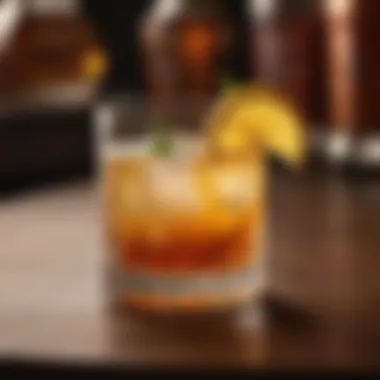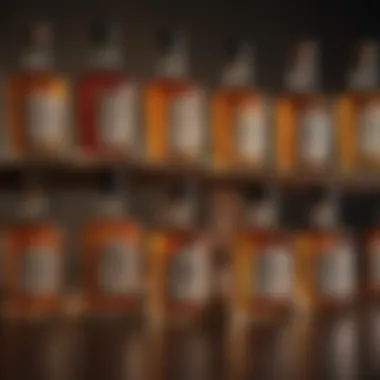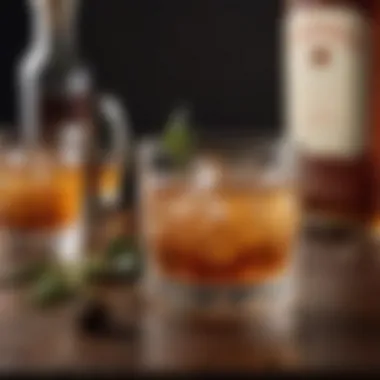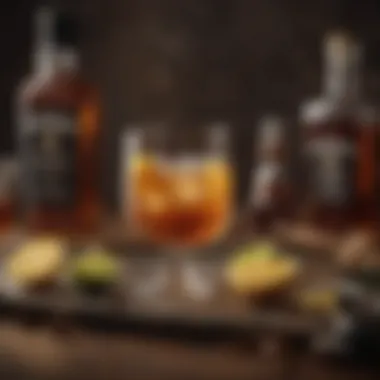Mastering Whiskey Cocktails: A Guide to Delicious Mixes


Intro
Whiskey cocktails have always held a special place in the hearts of many. The spirit's rich history and diverse flavor profile make it a versatile base for a myriad of mixed drinks. While some gravitate towards classic recipes, others delight in modern interpretations that showcase innovation in mixology. This exploration will guide readers through the nuances involved in crafting whiskey cocktails, spotlighting techniques, ingredients, and tips necessary to create remarkable drinks.
In this article, readers can expect to delve into various mixed drinks— from timeless concoctions such as the Old Fashioned to contemporary variations that surprise the palate. The focus will be not just on recipes, but also on the distinct attributes of different whiskey types, exemplifying how they influence the overall taste of each cocktail.
Recipe Overview
Crafting a whiskey cocktail is an art. As the base, whiskey provides depth and a warm character that enhances any mix. Each drink, while perhaps sharing fundamental components, showcases unique expressions determined by the whiskey used and the manner of preparation.
Key Ingredients and Tools Needed
Preparing whiskey cocktails requires some essential items. Here’s a quick rundown of what one needs:
- Whiskey: Bourbon, rye, or Scotch.
- Mixers: Soda, bitters, or sweet vermouth.
- Garnishes: Citrus peels, cherries, or herbs.
- Bar tools: Shaker, muddler, jigger, and strainer.
- Glassware: Rocks glass or coupe, depending on the drink.
The blend of these components leads to cocktails that vary widely in texture and flavor, appealing to a broad audience.
Step-by-Step Instructions
To truly master whiskey cocktails, following precise steps is crucial.
Detailed Preparation Steps
- Select your Whiskey: Choose one that aligns with your flavor preferences. Bourbon offers sweetness, while rye imparts a spiciness.
- Measure: Use a jigger to measure out the whiskey and mixers. This ensures a balanced drink.
- Combine: In a shaker, combine the whiskey with other ingredients. If your recipe calls for muddling—such as in a Whiskey Smash—add the herbs or fruits first.
- Shake or Stir: Depending on your drink, you may need to shake or stir. Shaking incorporates air, creating a lively texture. Stirring suits drinks served neat or on the rocks, allowing flavors to meld without excessive aeration.
- Garnish: Finish the drink with a complementary garnish that enhances both presentation and aroma.
Tips for Successful Execution
- Experiment: Don’t shy away from trying different whiskeys in classic cocktails. Each variant brings something new to the drink.
- Fresh Ingredients: Use fresh fruits and herbs for muddling. This elevates the taste and aroma of your cocktails significantly.
- Taste as You Go: Adjust sweetness or bitterness to suit personal preferences.
"Crafting a whiskey cocktail is about balance; understanding how each component interacts with the whiskey is key."
As the exploration continues, readers will gain insights into specific whiskey cocktails, allowing them to appreciate both the art and science behind each mixed drink.
Preface to Whiskey Cocktails
Whiskey cocktails have garnered a significant place in the world of mixology. The combination of whiskey's rich and complex flavors with various ingredients creates drinks that are both exciting and dynamic. Understanding whiskey cocktails is crucial for anyone interested in the broader culinary landscape as it bridges tradition with innovation.
Exploring whiskey cocktails opens a gateway to appreciate the nuances of different whiskey varieties. Each type, from bourbon to Scotch, offers distinct flavor profiles that can be highlighted or transformed through mixing. This affords mixologists and casual drinkers alike a creative outlet in which to experiment with tastes and textures. Moreover, cocktail culture has enjoyed a resurgence in popularity, prompting a renewed interest in crafting drinks that transcend basic mixtures.
As the art of mixology incorporates techniques and presentation, it is pressing to understand the foundational aspects of whiskey cocktails. Various methods such as shaking, stirring, and muddling are essential. Choosing the right glassware and garnishes can elevate a drink from ordinary to extraordinary. By mastering these components, enthusiasts can create aesthetically pleasing and flavorful cocktails that delight the senses.
In this article, we will explore the allure of whiskey, the fundamentals of mixology, different whiskey types, and classic and innovative cocktails. This exploration will enable both novice and seasoned mixologists to gain insights into crafting exceptional whiskey cocktails.
Understanding Whiskey Types
Understanding the different types of whiskey is crucial for both novice and experienced mixologists. Each variety brings its unique flavor profile, which can significantly alter the taste and character of cocktails. Knowing the distinctions allows bartenders to select the right whiskey for a specific drink, enhancing the overall experience. Furthermore, selecting the most appropriate type can resonate well with the occasion and individual preferences, making it a vital consideration for cocktail crafting.
Bourbon: Characteristics and Uses
Bourbon whiskey is predominantly produced in the United States and is often characterized by its sweet, full-bodied flavor. It must contain at least 51% corn in its grain mash, which contributes to its sweetness. Aged in new charred oak barrels, bourbon develops rich caramel and vanilla notes. This type of whiskey is often used in classic cocktails like the Old Fashioned and Whiskey Sour, as its sweetness complements both citrus and bitters effectively.
Rye: The Spicy Alternative
Rye whiskey offers a spicier flavor than bourbon, containing at least 51% rye grain. This provides a distinct peppery and fruity taste that can enhance many cocktails. Rye is often favored in classic drinks such as the Manhattan and the Boulevardier. Its bold character can stand up to substantial ingredients, making it an excellent choice for cocktails that require a more pronounced whiskey flavor.
Scotch: The Distinct Flavor Profile
Scotch whisky, known for its smokiness and complexity, comes from Scotland and must age for at least three years. There are various types of Scotch, including single malt and blended, which can lead to a broad range of flavors—from fruity and floral to rich and peaty. Using Scotch in cocktails can provide a sophisticated layer of taste, making it suitable for drinks like the Rob Roy. However, its unusual flavors may not blend well with all other ingredients.
Irish Whiskey: A Smooth Option
Irish whiskey is typically triple distilled, giving it a smooth and light quality that is distinct from other whiskeys. It usually contains a mix of malted and unmalted barley, leading to a more approachable flavor profile. Because of its gentleness, Irish whiskey works well in lighter cocktails or can be served neat for a lovely sip. The classic Irish Coffee is a prime example of its versatility.
Japanese Whiskey: An Emerging Trend
Japanese whiskey is gaining international recognition for its craftsmanship and quality. Inspired by Scotch, it often features delicate flavors and a focus on harmony. Although still relatively new to the market, it is being utilized in various cocktails. Japanese whiskey can offer a unique twist to drinks, presenting smoothness and ethereal notes that appeal to refined palates. As the craft expands, more innovative cocktails are emerging using this type, making it one to keep an eye on.


Each type of whiskey is distinct in flavor and character, influencing the harmony and balance of cocktails.
In summary, understanding whiskey types allows for a richer exploration of cocktail possibilities. Each variety offers something different, making it important to select wisely based on the desired outcome.
Classic Whiskey Cocktails
Classic whiskey cocktails hold a significant place in the realm of mixology. They not only represent timeless recipes but also showcase the versatility of whiskey as a base spirit. Each cocktail is steeped in history and tradition, offering flavors that are both familiar and complex.
These cocktails serve as a perfect introduction to whiskey for new drinkers and a nostalgic experience for seasoned enthusiasts. The importance of understanding classic whiskey cocktails lies in their foundational role in modern cocktail culture. By mastering a few iconic recipes, one can gain confidence in their mixology skills, allowing them to experiment with new flavors and ingredients.
Moreover, classic whiskey cocktails often highlight the characteristics of different whiskey types, teaching drinkers about the nuances of bourbon, rye, Scotch, and others. They can illustrate how small variations in technique or ingredient choice can dramatically alter the taste profile.
The Old Fashioned
The Old Fashioned is arguably the most iconic whiskey cocktail. Its simplicity is its charm, combining whiskey, sugar, and bitters, traditionally served in a rocks glass. The drink dates back to the early 19th century and stands as a testament to the adage that less is more.
To preparing an Old Fashioned, start with a sugar cube soaked in Angostura bitters. Muddle these together in the glass to create a sweet and aromatic base. Next, add a large ice cube and pour in the whiskey, stirring gently to combine the ingredients. Garnishing with an orange twist adds fragrant citrus notes that enhance the overall experience.
Whiskey Sour
The Whiskey Sour is another classic that fuses whiskey with sweet and sour elements. This cocktail balances the smoothness of whiskey with the tanginess of freshly squeezed lemon juice and sugar, making it a refreshing option.
To prepare a Whiskey Sour, you will need whiskey, fresh lemon juice, and simple syrup. Combine these in a shaker with ice and shake vigorously. Strain into a rocks glass filled with ice, and optionally garnish with a slice of lemon or a cherry. This cocktail's appeal lies in its refreshing taste and its ability to showcase the whiskey's character alongside zesty flavors.
Manhattan
The Manhattan is celebrated for its robust flavors, combining whiskey with sweet vermouth and bitters. This cocktail exemplifies sophistication and has been a staple in bars since its inception in the late 1800s.
To create a Manhattan, start by mixing two parts rye whiskey with one part sweet vermouth and a couple of dashes of aromatic bitters in a mixing glass filled with ice. Stir until chilled, then strain into a chilled coupe glass. A cherry garnish adds just the right touch of sweetness. This timeless cocktail appeals to those looking for depth and complexity in their drink.
Boulevardier
The Boulevardier is often seen as the whiskey lover's take on the Negroni. It combines whiskey with sweet vermouth and Campari, creating a rich and flavorful profile. The cocktail balances bitter and sweet, making it a well-rounded choice for any occasion.
To prepare a Boulevardier, mix equal parts bourbon, sweet vermouth, and Campari in a mixing glass with ice. Stir until chilled and strain into a rocks glass with ice. A twist of orange or a cherry can serve as a garnish. The Boulevardier's bold flavors make it an excellent choice for an evening nightcap or as a drink for more formal gatherings.
Classic whiskey cocktails not only tell a story but also provide a framework for understanding the art of mixology. They offer valuable lessons in balance, flavors, and ingredient selection.
Innovative Whiskey Cocktails
Innovative whiskey cocktails represent a dynamic evolution in the realm of mixology. They embrace creativity while showcasing the rich flavors of various whiskeys. Crafting these cocktails allows mixologists to explore unique ingredients and techniques, resulting in drinks that can surprise even the most discerning palate. The importance of this section lies in its ability to inspire both novice and experienced mixologists to step outside traditional boundaries. Exploring innovative cocktails can lead to a deeper appreciation for the complexities within whiskey itself.
Whiskey Sour Variations
The whiskey sour is a timeless classic, known for its simplicity and balance of flavors. However, variations of this beloved drink enable mixologists to experiment and personalize the experience. One popular variation includes the New York Sour, which adds a float of red wine on top, creating a visual and flavor contrast that is striking. Another interesting take is the Maple Whiskey Sour, which substitutes simple syrup with maple syrup, imparting a unique sweetness and depth to the drink.
Key Elements of Whiskey Sour Variations:
- Sour Mix: Adjusting the acidity level can drastically change the drink's profile. Use fresh lemon juice for brightness or explore other sources like grapefruit.
- Sweeteners: Substituting traditional sugars with agave nectar or honey can alter depth and richness.
- Garnishes: They are not just for decoration. A splash of bitters or a twist of citrus can enhance aroma and complexity.
Whiskey Smash
The whiskey smash is a refreshing cocktail that combines elements of a traditional smash with the robust character of whiskey. This drink is essentially a muddled cocktail, integrating fresh herbs, often mint, which lends a delightful aroma. A typical preparation involves muddling together fresh mint leaves with whiskey, lemon juice, and a sweet component, such as simple syrup. The result is a drink that is not only flavorful but also visually appealing.
Important Considerations for Creating a Whiskey Smash:
- Herbs: The choice of herbs can significantly influence the final taste. While mint is standard, experimenting with basil or thyme can offer unexpected notes.
- Whiskey Type: Using a smooth bourbon will yield a sweet, rounded flavor, while rye might produce a spicier profile. It’s crucial to choose the whiskey according to your flavor preference.
- Chilling: Always serve over crushed ice to enhance the refreshing quality of the cocktail.
Maple Whiskey Cocktail
This innovative cocktail introduces the comforting sweetness of maple syrup into the whiskey family. The Maple Whiskey Cocktail not only highlights the spirit but also showcases the versatility of maple syrup. This drink is garnished often with a twist of lemon to balance the richness of the syrup and enhance the drink’s overall flavor.
Guiding Principles for a Maple Whiskey Cocktail:
- Quality of Maple Syrup: Choose pure maple syrup for the best flavor impact. The grade of syrup can affect depth, with darker grades having more pronounced notes.
- Balancing Flavors: Adding a few dashes of bitters can create complexity. Aromatic bitters, such as Angostura, work particularly well.
- Glassware: A rocks glass or coupe can elevate the drink’s presentation, making it suitable for both casual and formal settings.


Innovative whiskey cocktails not only challenge the traditional norms but also invite creativity, allowing enthusiasts to redefine their whiskey experience.
Ingredients and Techniques
Understanding the ingredients and techniques used in mixology is fundamental for anyone looking to create whiskey cocktails. The right ingredients not only enhance the flavor of the drink but also affect its overall presentation. Techniques used during the mixing process contribute to the texture, temperature, and balance of the cocktail. Mastering these elements ensures the final product meets the expectations of both the creator and the consumer.
Essential Bar Tools
To craft exquisite whiskey cocktails, having the proper bar tools is essential. The following tools are workhorses in any mixologist's toolkit:
- Shaker: A good shaker is critical for mixing drinks thoroughly, especially those requiring aeration.
- Strainer: This tool is necessary for separating solids from liquids, ensuring a smooth pour. Options include a Hawthorne strainer and a fine mesh strainer.
- Jigger: Measuring is vital in mixology. A jigger allows for precise portioning of whiskey and other spirits.
- Muddler: This tool helps in releasing flavors from herbs and fruits, essential for cocktails like the Whiskey Smash.
It’s not only about having these tools, but also knowing how to use them efficiently. Familiarize yourself with their functions to elevate your mixing skills.
Garnishes and Flavor Enhancers
Garnishing enhances the visual appeal of a cocktail and can also add layers of flavor. Common garnishes for whiskey cocktails include:
- Citrus Peels: Lemon and orange peels are popular. They add brightness and aroma.
- Herbs: Fresh mint or rosemary can infuse a drink with freshness.
- Cherries: Beautifully colored cherries can bring a touch of sweetness and contrast.
In addition to garnishes, flavor enhancers can include:
- Bitters: A few dashes of bitters can deepen the flavor profile, especially in cocktails like the Old Fashioned.
- Syrups: Simple syrup or flavored syrup can adjust the sweetness to balance the drink.
Using these garnishes and enhancers thoughtfully will not only make your cocktails look better but also taste more complex.
Mixing Techniques Explained
Mixing techniques play a crucial role in the overall experience of the cocktail. Here are some common methods:
- Shaking: This technique incorporates air and chills the drink quickly, ideal for cocktails with juices or dairy.
- Stirring: This is a gentler method used for spirit-only cocktails. It allows for dilution without over-aerating.
- Muddling: When you mash ingredients together, you release their essential oils and flavors, important for drinks with fresh ingredients.
"The proper application of mixing techniques is what distinguishes a good cocktail from a great one."
Understanding these tools, garnishes, and techniques can greatly enhance your whiskey cocktail crafting skills, allowing you to impress guests with thoughtfully made drinks.
Serving Suggestions and Presentation
The way a whiskey cocktail is served can elevate its overall experience. Presentation involves not only the physical appearance of the drink but also the atmosphere and context in which it is served. A well-presentation of cocktails enhances the aesthetic appeal, stimulating both visual and sensory appreciation. For example, the right glassware plays a crucial role in defining the character of the drink.
Glassware Options
Choosing the right glassware is essential. Different shapes and sizes influence the aroma, taste, and temperature of whiskey cocktails. Here are common glassware choices for serving whiskey drinks:
- Old Fashioned Glass: Also known as a lowball glass, it is suited for cocktails like the Old Fashioned and Whiskey Sour. This glass allows for easy mixing and provides a robust presentation.
- Martini Glass: Ideal for drinks like the Manhattan, this glass emphasizes the elegance of the cocktail.
- Highball Glass: Used for diluted cocktails like the Whiskey Ginger, it can hold generous amounts of ice and mixers.
- Coupe Glass: Perfect for sophisticated concoctions, this glass offers a stylish option for serving cocktails like the Boulevardier.
Each glass serves not only a functional purpose but also contributes to the drink’s overall aesthetic.
Creative Garnishing Ideas
Garnishes add a finishing touch and can enhance the flavor profile of the drink. Creative garnishing can take a standard cocktail to the next level. Here are some ideas:
- Citrus Twists: Lemon or orange peels can add brightness. A twist can enhance aromatic qualities and freshen the look of the drink.
- Herbs: Fresh mint or rosemary can provide an aromatic quality. Herbs often contribute both visually and in flavor.
- Cherries: A classic garnish, maraschino or Luxardo cherries add sweetness, creating a pleasing visual and taste contrast.
- Spices: A sprinkle of ground cinnamon can elevate drinks, particularly those served warm in colder seasons.
Carefully chosen garnishes enhance both the appearance and flavor of cocktails.
In crafting whiskey cocktails, consider both the glassware and garnishes. The right choices will enhance the drinking experience for your guests, making the cocktail not only enjoyable but also memorable.
Whiskey Cocktails for Various Occasions
In the realm of whiskey cocktails, understanding the occasions that call for specific drinks enhances both the experience and enjoyment. Whiskey is versatile, playing a role in various social contexts. Whether it's a sunny afternoon gathering, cozy winter evenings, or festive celebrations, there's a whiskey cocktail tailored for the moment. Knowing the right drinks to serve can elevate gatherings and create memorable experiences.
Summer Refreshers
Summer invokes a desire for light and refreshing cocktails. Whiskey cocktails for summer often incorporate fruity ingredients and are served chilled. These drinks provide a balance between the rich flavors of whiskey and the refreshing nature of seasonal fruits. For instance, a whiskey sour with lemonade is a popular choice. The tangy lemonade complements the whiskey, creating a vibrant drink ideal for hot days. Other options include the Whiskey Smash, which features muddled mint and citrus, offering an invigorating sip.


Key Ingredients for Summer Refreshers:
- Fresh fruits like peaches, berries, or citrus.
- Herbs such as mint for a fresh touch.
- Light mixers like ginger ale or tonic water.
Winter Warmers
As the temperature drops, whiskey emerges as a comforting beverage choice. Winter warmers significantly utilize spices and rich flavors. Warm cocktails like the Hot Toddy, which combines whiskey, honey, lemon, and hot water, offer solace during cold months. The warmth of the drink is paired with soothing notes, making it perfect for cozy evenings by the fire. Additionally, incorporating flavors like cinnamon or nutmeg can enhance the festive spirit.
Essential Ingredients for Winter Warmers:
- Spices such as cinnamon and cloves.
- Sweeteners like honey or maple syrup.
- Citrus fruits to balance the spices.
Cocktails for Celebrations
Celebrations call for something special, and whiskey cocktails can make any toast memorable. Drinks for special occasions often showcase creativity and unique flavor pairings. A classic Manhattan can be an elegant choice, symbolizing celebration with its bold flavors. In contrast, modern interpretations like the Maple Whiskey Sour provide a fresh twist to traditional tastes. Crafting cocktails for celebrations involves not just flavors, but also presentation. A well-garnished whiskey cocktail can set the tone for an event and impress guests.
Popular Choices for Celebrations:
- Classic Manhattan - sophisticated and timeless.
- Maple Whiskey Sour - unique twist for adventurous palates.
- Whiskey Mule - a refreshing mix with a spicy kick.
"The right whiskey cocktail can transform an ordinary moment into a special occasion."
In summary, each season and celebration brings a distinct atmosphere that can be enhanced with the appropriate whiskey cocktail. By understanding how to match drinks with occasions, one can create enjoyable experiences and lasting impressions. Discovering various recipes and experimenting with ingredients can also expand one’s repertoire as a mixologist.
Pairing Whiskey Cocktails with Food
Pairing whiskey cocktails with food enhances the drinking and dining experience. Whiskey has distinct flavors that can complement or contrast various dishes. Understanding how to pair these drinks can offer a delightful gastronomic journey. As whiskey's profile ranges from smoky to sweet, matching it with the right foods can elevate both the drink and the meal. Some key elements to consider are flavor intensity, texture, and the style of the whiskey.
Appetizers and Light Bites
When considering appetizers and light bites, balance is key. For example, a Whiskey Sour, characterized by its tangy and sweet taste, pairs well with salty snacks. Consider cheese platters featuring sharp cheddar or blue cheese. These choices provide a delightful contrast without overpowering the cocktail.
Another option is smoked salmon. The fish's richness aligns well with whiskey's deep notes. Mini sliders infused with barbecue sauce can also complement whiskey cocktails. They add a layer of richness that enhances the drinking experience.
This is a great opportunity to experiment with different textures. Textured snacks such as tortilla chips or spiced nuts can also be ideal partners.
Main Courses: A Thoughtful Approach
Pairing whiskey cocktails with main courses requires a more thoughtful approach. Each whiskey variety can complement different ingredients. For instance, bourbon's sweetness enhances grilled meats, particularly pork. A Manhattan, richly flavored with vermouth, works well with beef dishes, especially those that are roasted or grilled.
Rye whiskey's spiciness lends itself handily to hearty dishes like braised lamb or peppered steak. These foods can accentuate whiskey's inherent sharpness. For a more elevated experience, consider serving a whiskey cocktail alongside a dish that contrasts its flavor profile. A spicy dish with citrus undertones may harmonize well with a smooth Irish whiskey cocktail.
Dessert Pairings
Dessert pairings are often overlooked, but whiskey can be a fantastic match for sweets. A rich chocolate cake can resonate with bourbon, making for a delightful combination. The sweet notes in the bourbon highlight the cake's flavors while also cutting through its richness.
Another great option is pairing a smooth Irish whiskey with a creamy cheesecake. The whiskey’s softness can balance the dessert's richness. Additionally, consider salted caramel desserts; the interplay of sweet and salty enhances the whiskey's depth.
When selecting cocktails for desserts, a sweet whiskey cocktail can work effectively. Incorporating elements like herbal infusions can provide an interesting contrast.
"Effective pairing requires awareness of flavors. Both food and drink should elevate each other."
In summary, when pairing whiskey cocktails with food, consider the strength and flavor profiles of the whiskey as well as the dish. The right pairing will enhance the overall meal, creating a memorable dining experience.
Ending and Further Exploration
The conclusion of this article centers on the significance of whiskey cocktails and the broader implications of their continued relevance in the culinary landscape. It highlights the evolving nature of mixology, which mirrors cultural trends and consumer preferences. The exploration of whiskey in cocktails not only deepens our appreciation for the spirit but also encourages creativity in crafting drinks. This section serves as a reminder that while classic recipes lay the groundwork, innovation is vital for keeping the concoction of whiskey cocktails lively.
The benefits of mastering whiskey cocktails span personal enjoyment, hosting capabilities, and even professional opportunities in the realm of mixology. For enthusiasts, diving deeper into the myriad of flavors and preparation styles expands their palate and drink repertoire. Understanding the subtleties of various whiskey types and their appropriate mixes opens new avenues for experimentation. This exploration invites both novices and seasoned drinkers to appreciate whiskey not just as a standalone spirit, but as a key player in a myriad of mixed drinks.
The Future of Whiskey Cocktails
As whiskey continues to gain popularity in the mixology scene, the future dovetails with innovation and tradition. Craft cocktail bars embrace unique ingredients, sustainability, and locally sourced products. Terroir is coming into focus, where ingredients reflect local flavors and environmental conditions. Expect ventures into different flavor pairings and preparation techniques, perhaps even incorporating unusual elements like smoked or barrel-aged ingredients.
A shift toward health-conscious cocktails could also arise. Mixologists may experiment with lower-calorie mixers or herbs to create lighter variants without sacrificing flavor. Moreover, collaborative recipes that blend whiskey with regional spirits or liqueurs might become prevalent. The advancement of technology and online resources, such as detailed recipe databases and social media platforms, can help enthusiasts stay informed about trends and how to execute them.
Resources for Whiskey Enthusiasts
For those looking to enhance their knowledge and skill in whiskey cocktails, several resources are valuable. Here are some suggested avenues to explore:
- Books: Titles that focus on whiskey varieties, cocktail recipes, and advanced mixology techniques can deepen understanding.
- Online Communities: Platforms such as Reddit allow enthusiasts to share recipes, tips, and reviews of different whiskeys.
- Social Media: Following mixologists on platforms like Facebook can provide inspiration and real-time updates on trends.
- Workshops and Tastings: Participating in local workshops offers hands-on experience and the opportunity to connect with fellow enthusiasts.
By engaging with these resources, whiskey aficionados can cultivate their skills and discover new perspectives on classic and innovative combinations.







